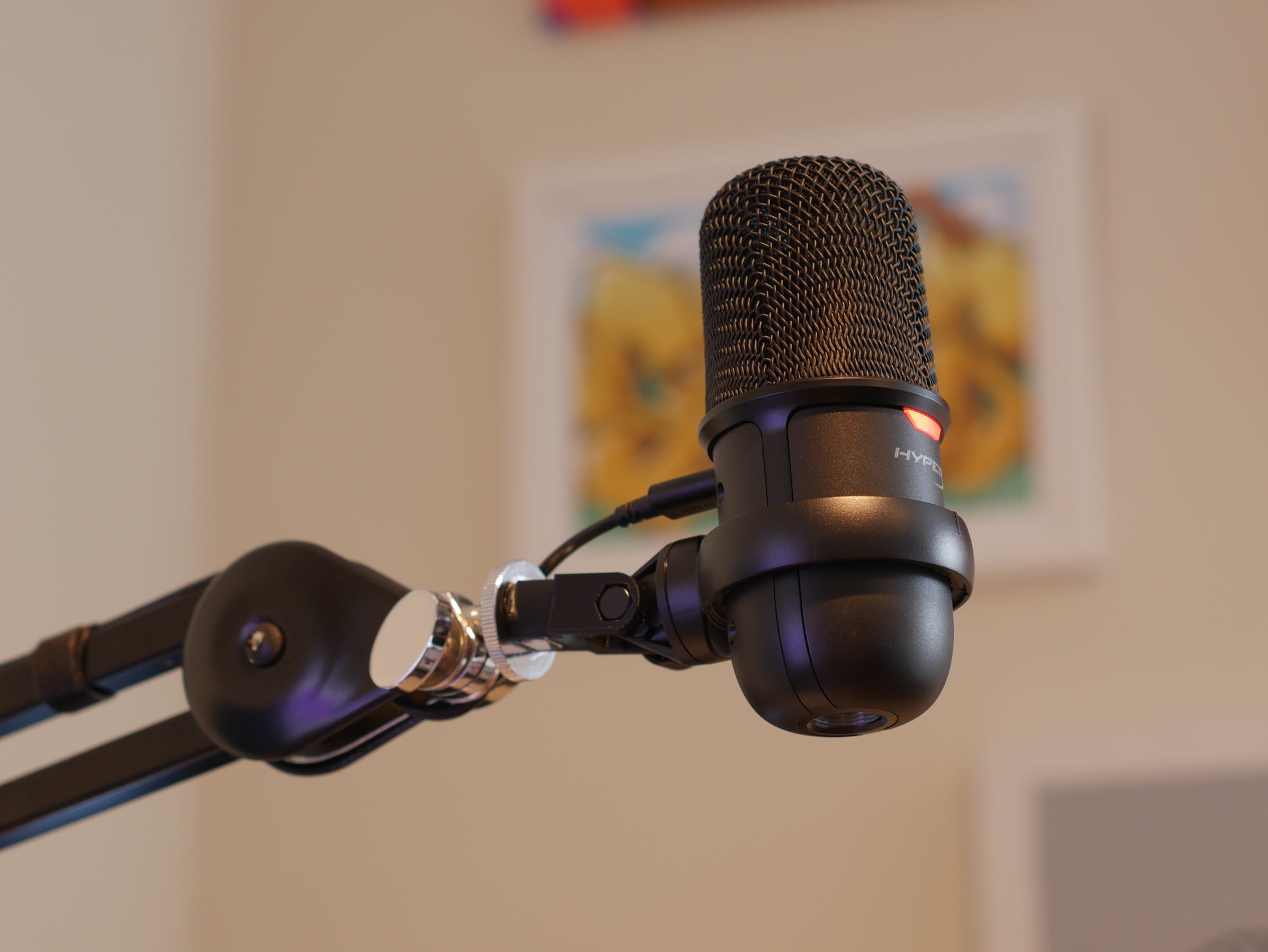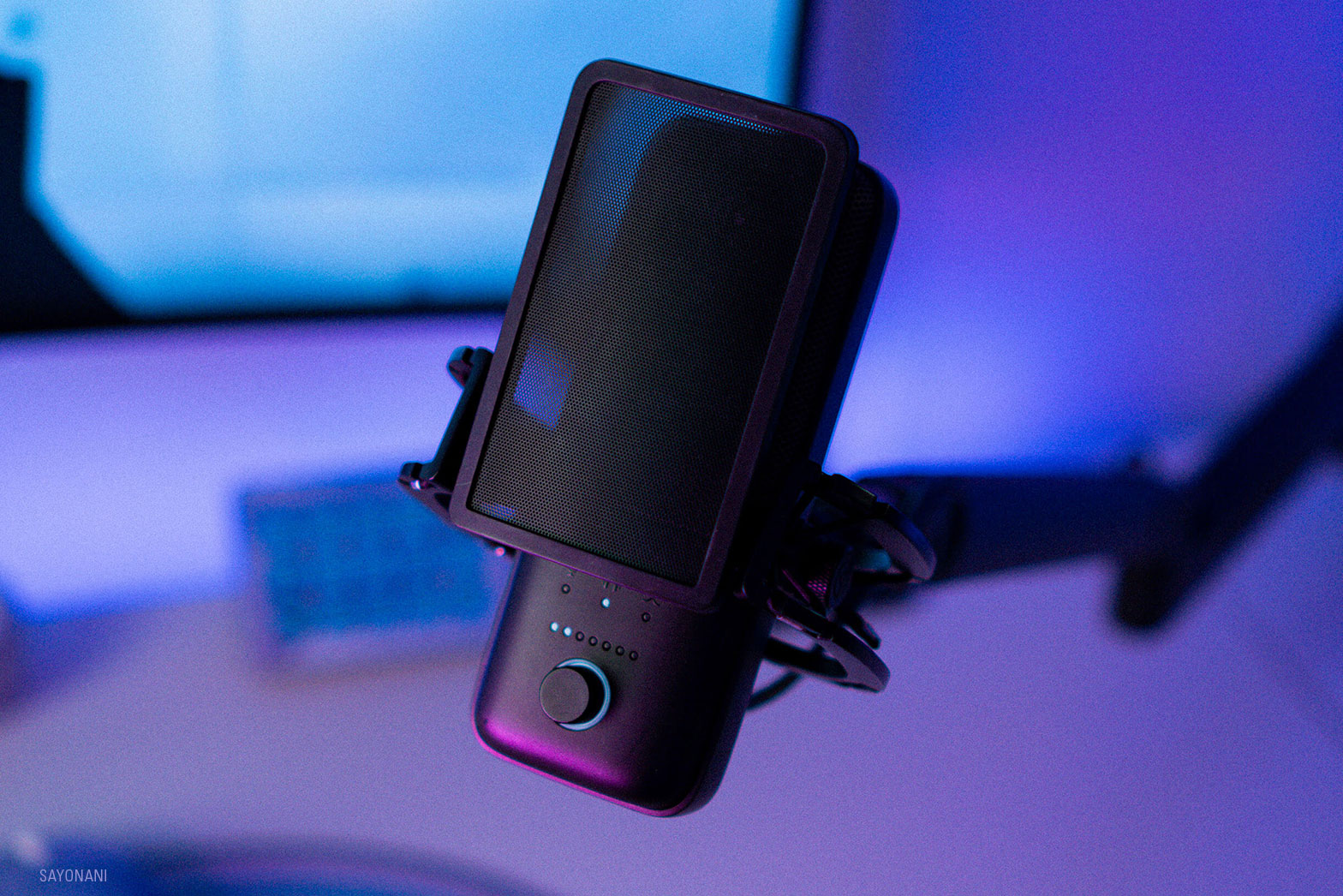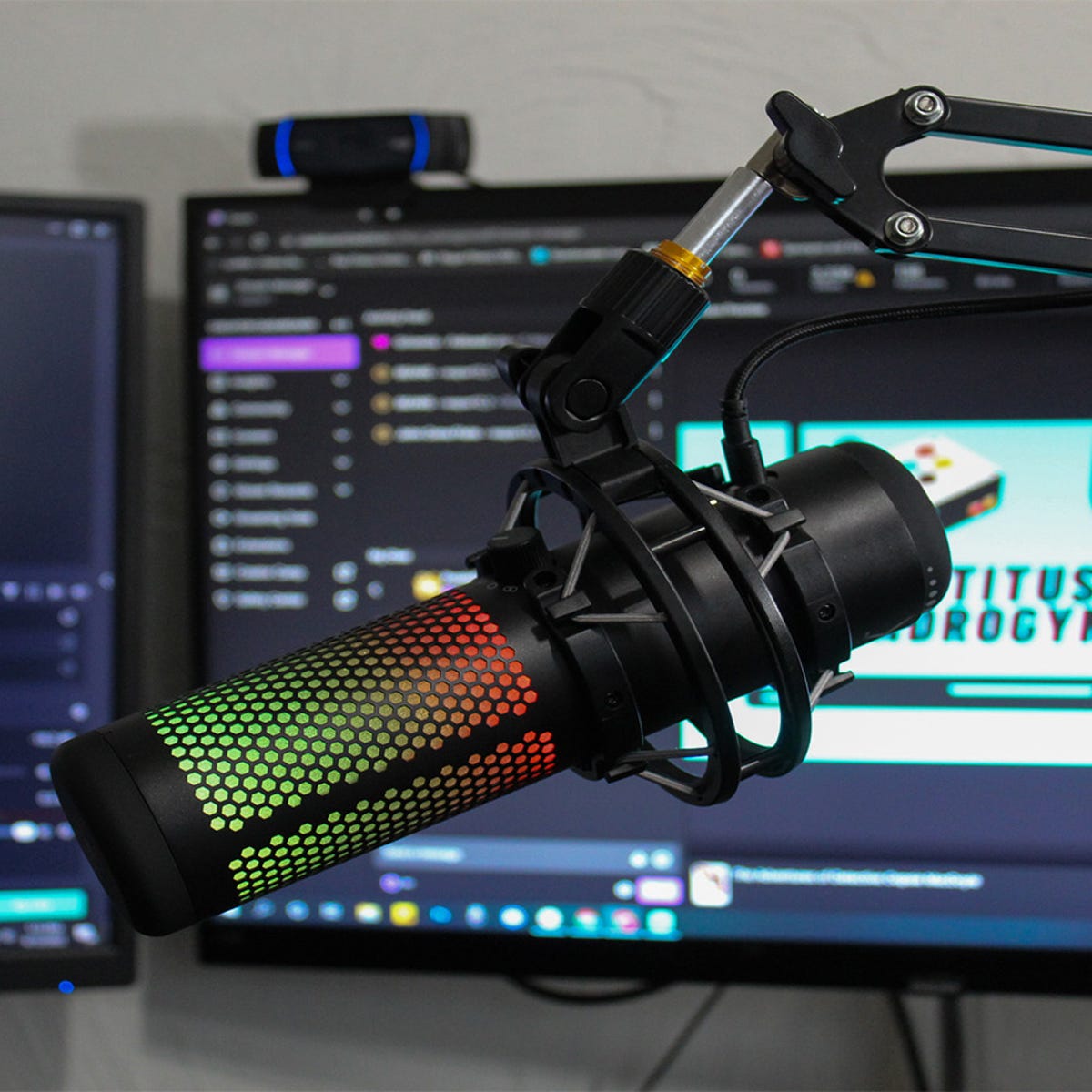I used to make do with the mini-microphones that came with my headset or webcam, but after being constantly disappointed with their quality, I decided to find the best streaming microphone on the market to elevate the quality of my broadcasts.
While a gaming headset is good enough for chatting with friends when playing online games, its mic quality isn’t high enough for live streaming.
If your goal is to provide your viewers with the best audio experience possible while getting rid of background noise, echo, and cutouts, you should try one ofthe microphones presented below.
 BLUE YETI X (4.6/5) ★★★★☆
BLUE YETI X (4.6/5) ★★★★☆
The Blue Yeti X is the best live streaming microphone I’ve ever used. It employs LED metering and a multifunctional smart knob that allows me to manage the sound without interrupting my stream.
Best streaming microphone

Type: Multi-pattern condenser | Polar Pattern: Cardioid, omnidirectional, bidirectional, stereo | Frequency Response: 20 Hz – 20 kHz | Connectivity: USB
I consider Blue Yeti X to be the best microphone for streaming and podcasting, as Logitech impressed me with how versatile it is and the impeccable sound quality it provides. It’s also incredibly simple to setup and offers diverse recording patterns. It’s a great choice for streamers interested in adding some creativity to their sound with real-time effects provided by Blue VO!CE, which even lets you add your own audio samples.
The biggest flaws of this model are its sensitivity to background noise and bulky build. However, it still delivers terrific results in most environments, be it a solo stream or a group discussion. I think its performance and cutting-edge feature set make Blue Yeti X the perfect option for streamers and gamers, especially since it’s offered for a competitive price.
Great for beginners

Type: Condenser | Polar Pattern: Cardioid | Frequency Response: 20 Hz – 20 kHz | Connectivity: USB
HyperX SoloCast is the best beginner microphone for streaming as it allows you to enjoy clear sound without emptying your wallet. It sports a convenient plug-and-play design that is perfect for new streamers and podcasters while delivering a level of quality that should satisfy a pickier user as well. I especially like SoloCast’s compact and sturdy build. It doesn't require a lot of desk space while looking professional and sturdy.
This microphone provides good sound quality, a stylish appearance, and intuitive controls – all for an attractively low price. It lets beginners capture pro-quality audio without having to invest in extra gear or an elaborate setup. As your needs continue to grow, you might become interested in a microphone with more cutting-edge features, but for a budget-conscious newbie – SoloCast is the best the market has to offer.
Pro-grade audio quality

Type: Dynamic | Polar Pattern: Cardioid | Frequency Response: 20 Hz – 20 kHz | Connectivity: USB/XLR
Having used Shure MV7 in the past, I was continuously impressed with its pro-grade audio quality and convenient design, which make it arguably the best microphone for Zoom meetings and a great option for streaming. It’s supplied with dynamic microphone technology that ensures my voice is captured with a high degree of warmth and clarity that is almost impossible to find in this price range.
I think Shure MV7 is also possibly the best USB microphone for streaming due to its plug-and-play design, and it also has an audio interface should you choose to use it. It’s pleasantly robust and has a professional look to it while the provided touch controls enable me to conveniently change gain, monitor levels, and mute the sound.
This mic offers a great balance between audio quality and user-friendliness. Moreover, the provided ShurePlus MOTIV application allows both beginners and experienced streamers to customize the captured audio to better suit their preferences.
For home studio/outdoor voiceover capture

Type: Permanently polarized condenser | Polar Pattern: Cardioid, omnidirectional, bidirectional, stereo | Frequency Response: 20 Hz – 20 kHz | Connectivity: USB
The Audio-Technica AT2020USB+ is the best budget microphone for streaming, especially if you’re a beginner who wants to enjoy good audio quality and use a standard headphone jack. The sound it captures is clean, rich, and natural, making it perfect for voice recording, be it during a live stream or podcast.
It's simple to use, pleasantly affordable, offers solid audio quality, and doesn’t require you to master any software or recording techniques to receive good results. Even though it lacks some features found in other microphones, like a mute button, its performance and dependability made the AT2020USB incredibly popular among streamers on a tight budget.

Type: Studio quality condenser | Polar Pattern: Cardioid, omnidirectional, bidirectional, stereo | Frequency Response: 70 Hz – 20 kHz | Connectivity: USB
The Wave:3 is the best microphone for gaming and streaming if you’re looking for a cutting-edge solution that provides rich audio and multifunctional software. I was stunned by how great it performs in both silent and busy home studio setups and I greatly appreciated its Clipguard technology. It also streamlines the process of mixing audio sources, which is an essential feature to have for any professional Twitch streamer.
The Wave:3 is the ultimate microphone if you want access to all the latest features designed for live streaming, as it offers superior anti-distortion functionality, a robust build, and handy Wave Link firmware. While it might be too expensive for beginners, the audio quality and versatility it provides more than make up for the asking price if you take your streaming endeavor seriously.
For engaging Twitch streams

Type: RGB condenser | Polar Pattern: Cardioid, omnidirectional, bidirectional, stereo | Frequency Response: 20 Hz – 20 kHz | Connectivity: USB
The HyperX QuadCast S might be the best microphone for streaming Amazon has to offer due to its fantastic sound quality and creative design solutions that made it a fan-favorite among content creators and regular gamers. It’s known for capturing rich audio, RGB customization, and intuitive controls. In addition to providing great performance, it also makes my streaming setup more eye-catching and visually appealing.
The HyperX QuadCast S is the best microphone for video recording if you value audio quality, aesthetics, and user-friendliness above everything else.
You’ll especially appreciate its RGB lights and the multitude of polar patterns that make it easy to fit into any streaming setup you might have. Even though it costs more than the more budget-friendly options on this list, the sense of style and clear sound it provides make it a worthwhile investment in your streaming career.
For PlayStation 4/5 gaming

Type: Condenser | Polar Pattern: Supercardioid | Frequency Response: 20 Hz – 20 kHz | Connectivity: USB
I consider the Seiren X to be the best cheap microphone for streaming if you’re interested in a stylish device capable of capturing clear sound. It employs a super-cardioid pickup pattern to isolate the speaker’s voice from the background noise. Additionally, it’s packed into a compact unit that makes it very easy to pack and transport if you tend to switch between different streaming setups often.
Seiren X offers respectable sound quality, which is further facilitated by the inclusion of its pattern and integrated shock mount that provides improved noise cancellation. Its small build makes it perfect for streaming setups that don’t have a lot of free space. While it doesn’t have any premium features, it offers all the essentials a beginning streamer might be interested in.
For recording musical instruments and vocalists

Type: Studio condenser | Polar Pattern: Cardioid, Bidirectional, Omnidirectional, Stereo | Frequency Response: 20 Hz – 20 kHz | Connectivity: XLR
Even the best wireless Bluetooth microphone for live streaming can’t come close to matching the crisp, clean sound produced by the Rode NT1-A. My voice comes across as crisp and professional and the microphone doesn’t pick up any background noise. Its cutting-edge functionality also minimizes vibrations and plosive sounds. NT1-A’s ability to nearly completely ignore ambient sounds makes it arguably the best noise cancelling microphone on the market.
This mic is a great option for live streamers interested in broadcast-grade audio. The clear, distortion-free sound it reproduces sets it at the top of its category. NT1-A’s biggest drawback is that you can’t use it without a dedicated audio interface, but if you want to receive the best sound quality possible, that’s more than a worthwhile investment.
For capturing broadcast-quality sound

Type: Dynamic (moving coil) | Polar Pattern: Cardioid, Bidirectional, Omnidirectional, Stereo | Frequency Response: 50 Hz – 20 kHz | Connectivity: XLR
The Shure SM7B is considered by many to be the best microphone for podcasting and live streaming. It offers fantastic noise cancellation, can process loud volumes without distorting the speaker’s voice, and feels a lot sturdier than the average mic in this price range. The audio it reproduces sounds clear and professional even without any post-processing.
Even though it can’t be used without purchasing a dedicated audio interface or preamp and its high cost can scare some people away, this model is still the best dynamic microphone for streaming so if quality is what you’re after, the Shure SM7B is worth every cent.
Frequency response – from 20 Hz to 20,000 Hz: is the recommended range for professional use. This parameter determines how capable the microphone is of producing various frequencies. It’s calculated in Hz and kHz and covers values that aren’t even discernible to the human ear.
Connection method – XLR or/and USB: these are the two most popular connectors used by streaming microphones. Each type has its share of weaknesses and strengths. If you get a mic with XLR connectivity, you won’t be able to pair it with your PC without getting a mixer or audio interface first.
The benefit of using XLR microphones is their superior audio quality. So determine what you value the most and pick the best camera and microphone for your streaming needs.
You can also come across a DSLR microphone, which is produced for specialized cameras and can be useful if you plan to stream outside of your gaming room.
Polar pattern – cardioid, omnidirectional, and bidirectional: this parameter determines the amount of volume your microphone can capture from different directions as well as its sensitivity to sound waves coming from multiple angles.
A cardioid polar pattern mainly captures audio from the front while minimizing background noise. Such a pattern can have one of two subtypes – super-cardioid and hyper-cardioid. It provides reduced sensitivity angles and superior capability to block ambient sound.
Bidirectional models can pick up sound from two sides – the front and back of the microphone. This type is often referred to as Figure of Eight.
Accessories – pop filter is an essential addition to most streaming setups. It does a great job of getting rid of unwanted noise during your live streams. It's also called a pop screen or pop shield and you can use it to significantly improve the quality of your voice capture.
If your goal is to capture only type of sound (for example, your voice), then you can get a USB microphone that combines the functionality of a preamp and converter in a single device to get a better price. However, if at some point you want to transfer to a different type of recording, you’ll have to replace the entire microphone altogether. By using an XLR microphone, you can swap out one mic for another without touching the rest of your setup. It’s worth noting that the best microphones for streaming in terms of audio quality have XLR connectivity (the rest of the setup is comprised of individual parts that you can pick and choose to your liking).
The are several reasons why you should prioritize dynamic models: they’re less sensitive to ambient noise, aren’t as demanding environment-wise, and don’t distort the speaker’s voice if they’re close to the mic. Condenser microphones are great at amplifying sound, but they require complete silence to deliver the best results, preferably in a room with noise-cancelling wall panels.
Your best choice for performing in front of a live audience is a dynamic microphone with a cardioid or super-cardioid polar pattern, as it will only capture the sound in front of it, while cancelling all the noise coming from the back and sides. If your performance involves interacting with the audience, for instance in a lecture hall or church, then the best wireless microphone for church and live performances should also offer an increased operating range and a long-lasting battery.
Bitrate determines how fast digital audio files are encoded. 16-bit and higher is a solid value, as higher bitrates are usually pointless for streaming considering the audio coding restrictions imposed by most streaming platforms.
It’s preferable to stream using microphones with a high sensitivity of about -42 to -30 Db. In a regular room, a high-sensitivity microphone will pick up the sound bouncing off the walls, but you can negate that issue by picking a model with an appropriate polar pattern. If you need to record multiple people talking at once, then a bidirectional or omnidirectional mic is the better choice. Lastly, you can get rid of ambient noise during audio processing and volume jumps can be dealt with using a compressor.